- Colleges & Universities

Best Graduate School Recruitment Strategies
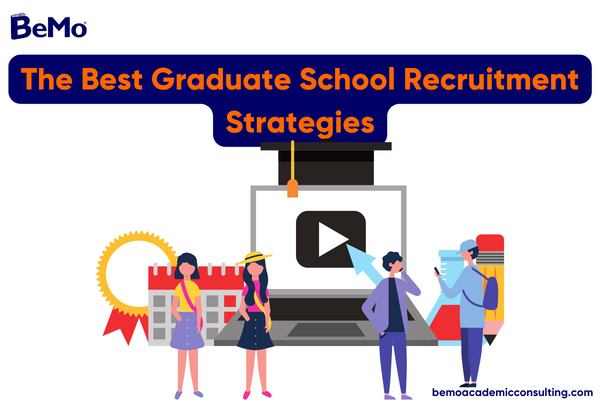
Discover the best graduate school recruitment strategies in 2024 and how you can implement them at your institution! Whether you are a school known for your graduate programs, or trying to attract students to innovative, new graduate programs, read on to learn how you can assess and audit your current recruitment efforts, and what you could be doing even better. From utilizing social media to offering student and alumni resources and perks, such as graduate school admissions consulting , there are many ways to appeal to prospective students.
Note: If you are a university, business, or student organization representative and want to partner with us, visit our partnerships page .
Article Contents 12 min read
Recruiting prospective students to your graduate program(s) requires a very strategic process, as graduate school application and acceptance rates can change annually, as can other factors that may impact students, such as technological advancements and shifts in trends. In recent years, graduate school application rates increased by as much as 7-10% across Canada and the United States, and admissions rates rose as a result. Generally speaking, society as a whole saw a shift in the way technology was utilized and incorporated into workplaces during the global pandemic. Because of this, many students found graduate school appealing due to the emergence of online classes and hybrid programs. Additionally, graduate programs—whether students intend to pursue further. According to a study by Statista , the number of Canadian students enrolled in a Master’s level program, or equivalent, has doubled in the past twenty years.
With that said, there are thousands of students who may be either set on attending a graduate program, or, completely new to the idea of attending graduate school. This is why it’s vital that you display your institution and program in a way that appeals to prospective students, and to do so, you must create a recruitment plan and strategize what works best for both your recruitment team, and your future students.
Graduate recruitment strategies and university partnerships are imperative to have, and your recruitment strategies should be ever-evolving for each new recruitment phase annually. Without the right materials, and the right execution plan to share information about your program to prospective students, students will be relying on whatever information they find online, what they hear from others, or, on whatever reputation your institution has. Instead of simply hoping students stumble upon your program’s website, you should strive to have several strategies in place for any prospective student, and at different levels of interest.
Graduate programs are costly, and, they are a business because they charge tuition for students to attend. If your program’s recruitment rates are low, or steadily decreasing, this means your institution isn’t generating as much revenue and could be missing out on several opportunities to earn more money, or attract prospective new students. With it being evident that students are increasingly interested in attending graduate school, it’s reasonable to assume that with the right recruitment strategies and approach to recruitment, many graduate programs could see a potential rise in admissions.
Even if your institution is a popular one with steady enrolment rates, it doesn’t mean your recruitment strategy is at it’s best! Your institution, as well as each individual program, should have its own culture and values or intended outcome. Along with this, the reputation for your school and the graduate program’s it offers is very important to uphold. Some students may opt to attend your program for reasons based on finances or convenience, for example, and while that’s certainly not a bad thing, you should strive to ensure your graduate programs are appealing, unique, and exciting so that students decide that your programs are their top choice.
BeMo strives to help universities and colleges attract and recruit top students by offering the university student benefits program. Educational institutions can benefit by attracting and retaining top students, and students gain from having unlimited access to our expert admissions consultants and career coaches, before and during their studies. Learn more on BeMo's university partnerships page to learn how a partnership strategy can increase your school's recruitment.
How do you make your graduate school recruitment strategies work? The best strategies help your institution:
- Stand out from other programs
- Highlight the unique benefits your program offers
- Attract unique, talented students
An additional factor that could be considered an important one in your recruitment strategy is how many resources your institution offers students, and what additional measures you take to ensure you’re also paying mind to your demographics as well and acknowledging any bias or areas of potential improvement. Offering resources, and telling prospective students how they can find information about financial aid, support services, or even pathway and internship opportunities is a great way to increase interest in your school, and also promote an inclusive environment for those who might be from an underrepresented population. For example, many medical schools implement diversity initiatives in order to adhere to—and develop— t he best medical school recruitment strategies for diversity . This type of recruitment strategy is applicable to all graduate programs, as prospective students come from all walks of life.
Ensuring that you have the best graduate school recruitment strategy is key because your institution will have better opportunities to increase student enrollment and offer enticing programs for all. Ideally, you want students to be excited about applying to their chosen program and feel eager to attend your school. You don’t want to be a ‘last choice’ to anybody, and with a great recruitment strategy in place, you will be able to generate interest in your institution, even across populations of students who may not be entirely sure if graduate school is for them, who may be the first in their family to attend graduate school and/or, who may need help accessing resources to make their application process and graduate school career go smoothly.
Think of it this way: recruitment is a lot like marketing! Your recruitment strategy is your opportunity to communicate the features of your program, and explain how students will benefit from attending your program. To do this, you can include an array of content—and use different approaches when sharing it! Students will benefit from being able to visualize how your graduate program can help them achieve their dreams and accomplish their career goals. This can all be done by utilizing digital tools, working with current technology and trends, and speaking directly to the audience you want to attract.
While you may be aware of some of the best college recruitment strategies currently recommended to post-secondary institutions, it’s important to note that graduate school can be a bit unique in comparison.
The approaches taken to actively recruit and entice students may be similar across the board, however, graduate students are a slightly different target demographic than prospective undergraduate students. Here are a few things that make prospective graduate students different from prospective undergraduates:
The campus experience is still important for graduate students, however, orientation, events, networking and even online communication\u2014especially for hybrid or virtual programs\u2014may be conducted differently than similar events that are intended for first-year undergraduates "}]">
The Best Graduate School Recruitment Strategies, and How to Implement Them
Understanding and implementing the best graduate school recruitment strategies means you’ll asses your current strategies, application rates, admissions rates, retention rates, and even your graduate program(s) overall culture and reputation. Along with this, gathering insight from current students, and alumni success stories and opinions is a great way to gain an understanding of what your current recruitment strategy is doing well, and, what could change.
If you’re somebody who feels your institution’s recruitment rates could improve, a good place to start is reviewing what you’re currently doing and deciphering where you’re going wrong. Too often, businesses and schools will host out-of-date webpages, mundane recruitment information, and also have a lack of digital engagement. If you’ve identified a strategy that has worked for you in the past, it’s a great idea to stick to it, but also consider how it could improve, and what could be done in addition.
Here are some of the best graduate school recruitment strategies:
#1: Tell the story of your institution, and its programs, in a unique way
Another marketing tip: stories sell ! Statistics, along with empty promises or broad statements, such as “Our students go on to work their dream career in X field” don’t mean much to students without a narrative tied to them. If you want students to choose your graduate program(s) above all others, tell them your unique history and provide some facts about your institution!
The term ‘unique selling proposition’ arises whenever businesses are looking to market their product and show their audience why they are the best option available…this also applies to academic institutions offering graduate programs! In a saturated market, that is, one where there are several similar options for prospective students to consider, ensuring that you stand out is the first and most important thing you can do to improve your recruitment strategy.
In order to understand what makes your programs and institution unique, you also need to have confidence in each program’s history, and, where your school is headed. Identify your school culture, along with the values and potential outcomes intended for each program. Along with this, looking at alumni success stories, and even speaking to current and former students for the purpose of curating inspiring recruitment materials is a great idea. If you’re a newer campus or institution, an easy way to understand what makes your school unique is to review and compare to what your competition offers—or does not offer. It’s vital that you set your school apart, turn your competition’s weaknesses into your program/institution’s strengths, and that your school’s uniqueness is evident in your recruitment materials.
#2: Utilize social media
Social media has been prevalent for some time now, and it’s extremely important that you utilize it! Having social media accounts that are active and organized for each individual program, for your institution, and even for recruitment-specific materials, such as a ‘prospective students’ group, is a great way to encourage engagement from prospective students, and stay current. Social media evolves rapidly, and this is why it’s important to update your recruitment strategies often. In addition, your future graduate students may not be as involved with certain aspects of social media, such as TikTok, as younger, potential undergraduates are. Pay attention to trends and make note of who your target audience/demographic is. A bit of research can help you identify what platforms may be best, and what materials students are most likely to engage with! Most importantly, the message you convey must be clear and concise across all platforms, and either resonate with them, and/or encourage action. Whether the student simply saves your post, follows your account, likes your photo or completes another call-to-action, it’s imperative that you produce materials that prompt action.
You can utilize social media to not only tell your school’s story and promote its programs, but to offer value to students, such as tips or important information that also increases their awareness of your institution and programs. You can also use social media to connect with various communities and reach out to underrepresented populations of potential students. You can use social media to notify prospective students of upcoming recruitment events, host virtual recruitment events or Q&A’s, encourage them to participate or follow along, and, entertain them by sharing relevant, relatable content, such as video testimonials from alumni, or footage of fun or professional events that take place on your campus.
Finally, if you’re looking to purchase ads to advertise your graduate programs, YouTube, Facebook, Instagram and TikTok are effective for targeted marketing and advertising.
#3: Host the right recruitment events and prepare concise materials
Your prospective students may have cell phones and laptops by their side daily, but it’s still important to note that students often enjoy the opportunity to engage in face-to-face conversation with recruitment personnel, current students, and/or instructors.
Hosting recruitment events or open houses on your campus is a great way to generate interest in your graduate programs. Whether you’re hoping to attract undergraduates, from your institution or another, or mature students, you can get strategic about recruitment events and where you decide to set up your physical information booth. You may wish to visit colleges with undergraduate programs with students who may be interested in your graduate program. One way to decipher where your current enrollment comes from is by analyzing student data and noting what 5-10 institutions the majority of your current graduate students came from. If you’re looking to diversify your population more, you may want to reach out to schools or communities that you haven’t seen students from.
Finally, you should ensure you have eye-catching, informative handouts available to pass out to students. For graduate programs, these should be very program specific, rather than being general information about campus life. With your materials, you can also provide information about program-specific internship or employment opportunities, financial aid, and additional resources or perks you offer to your students exclusively. It’s crucial to only provide students with relevant and appealing information, and it’s also quite handy to include a prompt for students to connect with you online. QR codes, or easy-to-recall web addresses or social media information is beneficial to include on your physical handouts. Your handout may get tossed aside once the student discovers your web page or social media account, but that isn’t necessarily a bad thing! Students who interact in-person, and receive physical materials will very likely engage with the prompt to learn more online, which only increases interest in your graduate program and your web traffic!
Even if you present your graduate programs well and have an incredible online presence, students may still be unsure if they should attend your institution or another. That is only natural, but this is where you should implement unique perks and emphasize the access to specific resources that students at your institution will have.
For example, if your graduate program includes a renowned internship opportunity for several lucky students and plenty of 1-on-1 time with instructors, you should make these details pertinent in your recruitment materials. If you’re the only program offering access to innovative technology and your alumni are thrilled with their overall experience, share this message with prospective students in a variety of forms, such as social media, and in your recruitment materials.
As mentioned prior, many graduate students may be seeking additional resources to help ease their transition to graduate school, and even help them along with way. Mental health services, financial aid resources, such as bursaries or grants, and even social and professional networking groups on campus should be mentioned in your recruitment materials. If your campus/program doesn’t offer these types of resources currently, it’s advised determine what your students’ value, and devise a plan that could include resources that would make their lives easier. Thousands of students feel deterred to attend graduate school due to barriers, whether they’re personal, socioeconomic, or due to their own uncertainty of potential success. Use your unique qualities and storytelling ability to paint a picture for students: tell them what you offer, why it’s unique, how they’ll thrive on your campus, and what they’ll learn and achieve in your graduate program! And, should they require additional help, let them know what resources will be available to them should they decide to become a student at your school.
Additional resources and support you may choose to offer students can include alumni perks and lifelong discounts. For example, many institutions and specific programs offer their alumni discounts on insurance, hotels, air travel, and even local attractions. This may sound insignificant, but it’s certainly a perk that students may find enticing, especially if it’s one that they can enjoy throughout their lives once they graduate from your school. Another support option you could offer could be access to academic consulting services. Services like BeMo Academic Consulting can help students reach their full potential, get into their dream programs, and prepare for the admissions process for a variety of programs, including graduate school! You may wish to offer this service to current students and alumni at a discounted rate—especially if they plan to continue their education, or, if they have a dependent who could utilize the service—or, you may even opt to reach out to specific populations of prospective students and offer a discount code to allow them to access academic consulting services. This can be especially beneficial to students who are first generation applicants, who have low GPA’s, or who are overwhelmed by the admissions process.
The additional resources and services you offer can vary by program, and certainly tend to vary by institution. However, if you’re hoping to stand out and appeal to a diverse range of students in the near future, it’s important that you consider where some potential students may be struggling, and, who may be missing out on the graduate school opportunity entirely due to lack of support or resources. Further to this, understanding how to reach your intended audience, understanding their values and professional goals, and emphasizing how your graduate program(s) will help them achieve their dreams and move forward toward their careers is essential. And, you must communicate all of this in a concise manner, through the appropriate digital channels and platforms, and physical materials as well.
Student retention refers to the number of students who complete their program at your institution. Retention, or ‘retaining someone’ for the expected duration of time is favorable in workplaces, for example, as well as schools. If your institution is able to retain, say, 90% of your students for the duration of their program, that means you see very few drop outs and students are completing their courses, and eventually graduating!
Student retention is very important in higher education because for every student that drops out, your institution is losing money, and perhaps its reputation! Students will inevitably drop out, of course, as some realize that their chosen path isn’t for them. However, it’s unfortunate if students are dropping out for preventable reasons, such as feeling unwelcomed or overwhelmed by the campus experience, disliking their program instructors, feeling a lack of support, being confused about their future, grades or financial abilities, or being offered limited opportunities for engagement. Learning why students are leaving, what could have prevented their departure, and what can be done to better the student experience is all a part of building a retention strategy and understanding best practices.
Retention practices are always ongoing! Seldom do students not require support in their upper years of study. Your institution and your programs should understand how to support and engage with students at all levels of schooling. Orientation and communication with your first-year students is very important because it sets the tone and makes an impression of them as they begin their educational journey, however, students will require support and opportunities throughout their years at your institution in order to succeed, thrive, make important decisions about their career path, and stay enrolled in their program.
Yes! Retention is important for all levels of higher education. Undergraduate students, MBA students, medical students, law students, and so on.
No matter what type of focus your institution has in mind, you’ll want to ensure you’re able to retain students throughout the duration of their program in order to help them succeed and send them down a promising career path. If your students are dropping out at concerning rates, especially in their upper years or in a graduate/professional program, something isn’t right!
The best practices for student retention in higher education include: providing exciting inclusive orientation activities and utilizing social media groups/pages for students in all years, but especially first years. Ensuring that students have ample networking and mentorship opportunities, dedicated faculty, encouraging academic advising, and providing resources, support and guidance to students who are struggling with their academics, personal struggles or finances are all great ways to retain students. Along with this, using surveys or other evaluations to gauge student success, impressions and feedback is a great way to figure out what needs to be improved upon at your institution.
Start by looking at your current strategies and practices, as well as your data. Is your drop-out rate standard, or, are you losing students frequently? If so, you’ll want to hone in on what programs and years the students were in, and see if you recognize any patterns. You may want to consider student surveys and ask for student feedback, as well as feedback from faculty, as you determine what your next best steps will be, whether it’s curating a better social media and communication/networking environment for your first-year students, or improving your academic advising practices, or anything in between.
Yes. It may require some strategic analysis, planning, and work, but a low retention rate often reversible when the contributing factors are identified and corrected!
Offering academic consulting to students will appeal to them as being more than just a perk, but as a means to help guide them on their academic journey and path toward graduate or professional school. Students who become discouraged throughout their program, perhaps who have a low GPA or feel overwhelmed by the thought of accomplishing their career goals, are at risk for dropping out of their program entirely. Academic advising can help students with their current studies and barriers to an extent, however, academic consulting is more of a preparatory service that helps students approach interviews, exams, and multi-step applications with confidence.
Want more free tips? Subscribe to our channels for more free and useful content!
Apple Podcasts
Like our blog? Write for us ! >>
Have a question ask our admissions experts below and we'll answer your questions, get started now.
Talk to one of our admissions experts
Our site uses cookies. By using our website, you agree with our cookie policy .
Do you want us to increase your student recruitment, profit and revenue – at no cost to your institution?
Graduate School
- Resources to Prepare for Graduate School
- Adonara Mucek, Ph.D. Geology '17
- Adriana Mendoza, Ph.D. Mathematics '14
- Andrew Olsen
- Becca Maher ('21, Ph.D.)
- Bryan Lynn, Ph.D. Integrative Biology
- Celeste Frazier Barthel, Ph.D. Education '21
- Diane Brandt
- Francesca Germano, Toxicology, M.S.
- Garrett Rogers
- Jafra Thomas
- Jen Hayes, Horticulture, PhD
- Jordan Jimmie
- Jordan Spradlin, Public Health, MPH
- Kalina Fahey, Psychology, Ph.D.
- Katie Stelling, Earth, Ocean and Atmospheric Sciences, Ph.D.
- Kelsey Contreras
- Layla Ghazi
- Marie Tosa, Ph.D. Wildlife Sciences
- Sara Letton
- Tiara Walz, Ph.D. Public Health
- Glossary of Terms
- Master's Students
- Doctoral Students
- Certificate Students
- Graduate School Orientation 2023
- Graduate Teaching Orientation 2023
- Do I Qualify to Attend Graduate Summer Step?
- Orientation for Winter, Spring and Summer Terms
- Co-sponsorships
- Your Graduate Committee
- Student Resources
- Grad Research Photo Competition
- Tips for Scheduling Committee Meetings
- Program of Study
- Formatting a Thesis or Dissertation
- Pretext Pages Templates
- Commencement
- Grad Inspire
- Grievance Procedures
- Request a Workshop
- Earning Concurrent Degrees or Pursuing a Dual Major
- Career Preparation
- Grad Writing Group Challenge
- Graduate Writing Center Online
- Changing or Adding a Degree, Major or Certificate
- GRAD 420 - Graduate School Preparation
- GRAD 512 - Current Issues in Higher Education
- GRAD 513 - Professional Development in College and University Teaching
- GRAD 516 - Graduate Teaching Seminar
- GRAD 520 - Responsible Conduct of Research
- GRAD 521 - Research Data Management
- GRAD 542 - The Inclusive College Classroom
- GRAD 543 - Dialogue Facilitation in Professional Contexts: Skills and Practice for Graduate Students
- GRAD 550 - Introduction to Online Course Development and Facilitation
- GRAD 560 - Theories of Teaching and Learning
- GRAD 561 - Course Design and Methods
- GRAD 599 - Creating Happiness
- GRAD 599 - Interdisciplinary Teams
- WR 599 - Graduate Writing for English Language Learners
- WR 599 - Scientific and Technical Research Writing
- WR 599 - Writing Workshop for Thesis and Dissertation Writers
- OSU Grad Advantage
- Graduate Faculty Membership
- Graduate Council Representatives
- Policy updates
- Holistic Admissions
- Defining the Graduate Mentor
- The Importance of Mentors
- Apprenticeship and Mentoring
- Mentor and Mentee Pairing
- Maintaining and Evaluating Mentoring
- Suggestions for Mentoring Programs
- Handbooks, Manuals, and Guides
- Mentoring Bibliography
- Communication Items
- Detailed Considerations for a Joint Degree Program
- MOU Outline for Creating a Joint Program
- College and Program Recruitment Representatives
Graduate Recruitment Tips
- Helpful Recruitment Links
- Shared Graduate Recruitment Schedule
- Leave of Absence and Family Medical Leave Eligibility
- Mentor Training for Faculty
- Student Funding
- Student Progress
- Student Progress Information for Programs
- Student Registration Information
- August 2023 Newsletter
- Sept 2023 Newsletter
- October 2023 Newsletter
- November 2023 Newsletter
- April 2024 Newsletter
- Dec 2023 Newsletter
- Feb 2024 Newsletter
- Jan 2024 Newsletter
- March 2024 Newsletter
- Strategic Plan
- Request Info
- Current Students
- Faculty Resources
You are here
Look at trends.
Do you notice that you receive a large applicant pool from a specific institution or area of the country? Are certain applicants not committing to your program? Consider these findings when creating your recruitment plan . Look at national trends to see if other institutions are experiencing something similar. Resources like CGS Graduate Enrollment and Degree report and IIE Open Doors Report can help you compare.
Identify your program’s strengths
Identify at least three highlights of your program to use in recruitment. These could include rankings, research access, student funding, location, job prospects or student engagement. Use these highlights when creating recruitment material or when having conversations with prospective students.
Review your program’s website
As a prospective graduate student, how easy is it to find information on your webpage? How many clicks does it take to get there? Ask people who are not familiar with your page to try to find information. Ask current students for their input. Review your website periodically to ensure things are up to date and hyperlinks still connect.
Be responsive
Responsiveness can make or break an applicant’s commitment. Try to ensure emails, phone calls and other methods of communication are replied to quickly and thoughtfully. Consider creating a standard initial response email faculty can use when they receive general inquiries. An example can be found in Recruitment Templates and Printouts.
Identify college or program recruitment representatives
Identify current graduate students who can share and articulate the graduate student experience for your unit with prospective students through email, during campus visits or at recruitment events. Be mindful of the time commitment you are asking from the student.
Also, identify faculty and staff who are skilled and successful at recruiting. Provide resources and opportunities for them to pursue recruitment outreach. While there may be primary recruitment representatives for your unit, remember that EVERYONE can play a role in recruitment.
Visit College and Program Recruitment Representatives for more resources.
Get your name out there
External conferences are opportunities to promote your program through print ads, hosting an expo table or having OSU attendees share information while networking. Undergraduate poster sessions are a great place to interact and share information with qualified students as well. Whoever is representing your unit should be able to speak to your program’s highlights and website, and have a way to collect or share contact information. Send a follow-up email to collected contacts to keep dialog moving. Request Graduate School Material to send with representatives.
Oregon State undergraduates are a local recruitment source. Participate in different on-campus events (Meet the Majors, Career Development Center workshops, etc.) to spread awareness about your graduate programs. Advertise open lectures to undergrads, offer to speak to student clubs or organize a graduate programs info session. Social media and email communications are other ways to get your name out there.
Continue recruitment post-admission
Getting a student to apply and be admitted is just the first step. The next task is having the student commit and enroll. Continue communication with admitted/committed students. Have faculty or program directors call admitted students to congratulate them and answer any questions. Invite admitted graduate students to join a Facebook or Slack group where they can meet each other and converse before the term starts. Note that students residing in China will need a VPN to access these platforms.
Host a campus visit for admitted students to connect with your program virtually or in-person. During the visit, allow opportunities for admitted students to interact with unit faculty, staff and students and to learn more about program specifics. An example agenda can be found in Recruitment Templates and Printouts. Partner with the Graduate School to present an OSU Graduate School for Prospective Students to visiting students.
Contact Info
Graduate School Heckart Lodge 2900 SW Jefferson Way Oregon State University Corvallis, OR 97331-1102
Phone: 541-737-4881 Fax: 541-737-3313
- Programs - Majors, minors and certificates
- Academic Progress
- Student Success
- Faculty Support
- Staff Directory
- Graduate Catalog
This New Year, our focus is clearer. Wiley Education Services is now Wiley University Services. Explore our flexible, career-connected services.

Is Your University Prepared to Recruit Graduate Students to Online Programs?
Last updated on: July 10, 2023
Overall, online program enrollment has increased significantly, thanks to the pandemic initially driving the shift in modalities. And for some groups of students pursuing higher education, this shift has continued. In fact, more full-time MBA students are now enrolled in online programs than on-campus.
Graduate students’ needs are much different than undergraduates’ needs. Some students, especially those pursuing master’s degrees, doctorates, and PhDs, no longer prefer to attend university courses on-campus—they’re looking to complete courses online instead.
So, how can you encourage postgrads to enroll in your online program? Our Senior Directors of Enrollment Heather Brown and Bernard Carter have outlined four student recruitment strategies your university can implement to help make your program students’ top choice.
1. Develop a streamlined admissions process
From the start, the process needs to be easy. These postgrads are often working adults with families, jobs, and many other commitments. Investing substantial time into navigating complex university applications can be very frustrating and discouraging for them. But a reasonable application process can reflect that your university understands their unique challenges.
Simplify enrollment requirements where possible
During the pandemic, universities removed entrance exam requirements. Recently, some schools have brought them back, but many students don’t have time to take them. When a university requires a GMAT, it risks prospective students abandoning the application and looking for other online programs.
Remove impractical application steps
When a PhD candidate has already been working for 20 years, it’s not realistic for them to hunt down five letters of recommendation. As such, it’s important to remove application barriers and ensure every requirement brings value. Résumés are an appropriate way to evaluate prospective students without inconveniencing them, for example. Considerations like this demonstrate you understand learners and respect their time.
2. Champion flexibility
Online learners juggle a lot of responsibilities, so prospective students need to feel that your university’s programs maintain flexibility. A graduate student may manage work assignments and personal obligations, all while completing their thesis. Your university must ensure that faculty feel capable of supporting students’ learning, social, and emotional needs as they balance their work, school, and personal lives.
Prioritize asynchronous class sessions
Although many students choose to attend an online program close to where they live, they don’t want to be told when or if they need to go to campus. Some of them may rely on not having to attend regular class sessions on campus and prefer to learn material at their own pace when it’s convenient for their schedules.
For some students, it may never be an option to attend synchronous sessions. So, if faculty host synchronous meetings, your university should encourage them to provide flexible options, such as recorded lessons, to accommodate the needs of students who can’t attend.
Enjoying this article? Fill out our quick two-step form to stay up-to-date with our latest reports and infographics.
Step 1 of 2
- First Name *
- Last Name *
- Country * Afghanistan Albania Algeria American Samoa Andorra Angola Antigua and Barbuda Argentina Armenia Australia Austria Azerbaijan Bahamas Bahrain Bangladesh Barbados Belarus Belgium Belize Benin Bermuda Bhutan Bolivia Bosnia and Herzegovina Botswana Brazil Brunei Bulgaria Burkina Faso Burundi Cambodia Cameroon Canada Cape Verde Cayman Islands Central African Republic Chad Chile China Colombia Comoros Congo, Democratic Republic of the Congo, Republic of the Costa Rica Côte d'Ivoire Croatia Cuba Curaçao Cyprus Czech Republic Denmark Djibouti Dominica Dominican Republic East Timor Ecuador Egypt El Salvador Equatorial Guinea Eritrea Estonia Ethiopia Faroe Islands Fiji Finland France French Polynesia Gabon Gambia Georgia Germany Ghana Greece Greenland Grenada Guam Guatemala Guinea Guinea-Bissau Guyana Haiti Honduras Hong Kong Hungary Iceland India Indonesia Iran Iraq Ireland Israel Italy Jamaica Japan Jordan Kazakhstan Kenya Kiribati North Korea South Korea Kosovo Kuwait Kyrgyzstan Laos Latvia Lebanon Lesotho Liberia Libya Liechtenstein Lithuania Luxembourg Macedonia Madagascar Malawi Malaysia Maldives Mali Malta Marshall Islands Mauritania Mauritius Mexico Micronesia Moldova Monaco Mongolia Montenegro Morocco Mozambique Myanmar Namibia Nauru Nepal Netherlands New Zealand Nicaragua Niger Nigeria Northern Mariana Islands Norway Oman Pakistan Palau Palestine, State of Panama Papua New Guinea Paraguay Peru Philippines Poland Portugal Puerto Rico Qatar Romania Russia Rwanda Saint Kitts and Nevis Saint Lucia Saint Vincent and the Grenadines Saint Martin Samoa San Marino Sao Tome and Principe Saudi Arabia Senegal Serbia Seychelles Sierra Leone Singapore Sint Maarten Slovakia Slovenia Solomon Islands Somalia South Africa Spain Sri Lanka Sudan Sudan, South Suriname Swaziland Sweden Switzerland Syria Taiwan Tajikistan Tanzania Thailand Togo Tonga Trinidad and Tobago Tunisia Turkey Turkmenistan Tuvalu Uganda Ukraine United Arab Emirates United Kingdom United States Uruguay Uzbekistan Vanuatu Vatican City Venezuela Vietnam Virgin Islands, British Virgin Islands, U.S. Yemen Zambia Zimbabwe
- Comments This field is for validation purposes and should be left unchanged.
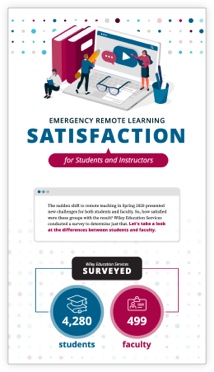
Design compact programs
These students also don’t want a long, drawn-out program since they likely have very specific goals that inspired them to continue their higher education. In fact, our 2022 Voice of the Online Learner report showed that 69% of learners want a program with a fast completion time.
“Online graduate students want to know two things: how much and how long. A university’s programs need to be reasonable on both,” says Heather Brown, Senior Director of Enrollment.
These students don’t have the same expectations about higher education as undergraduates. Shorter programs mean these postgrads can get started on reaching their goals faster, so your university must show willingness to meet students’ timing expectations and champion their ambitions.
3. Focus on affordability
We also found that 74% of online learners rate program tuition and fees as a very or extremely important factor in their decision. Especially right now, with high inflation, learners are worried about debt. Since cost can be such a significant barrier to prospective students, it’s key that your university is ready to help when possible.
Offer financial support when applicable
“We have seen some students this fall who made it all the way to the end of the process. They were registered and then, at the last minute, changed their mind. They are watching the state of the economy closely and are opting out of taking on any debt,” says Heather.
Efforts to lessen financial burdens, such as tuition discounts, scholarships, or waiving the cost of textbooks, are likely to motivate students to enroll in your program over another. For example, 31% of online learners said a scholarship for as little as $500 could encourage them to enroll in a program.
4. Emphasize alumni experiences and program outcomes
Collecting data on alumni accomplishments is a useful strategy for appealing to goal-minded students. For example, highlighting the average salary of graduates of your programs can help prospective students understand your role in preparing them to reach career goals.
“Students want to hear success stories. Universities should focus on getting in touch with their alumni and share the types of jobs they are working in,” says Bernard Carter, Senior Director of Enrollment.
Showing examples of alumni achievements can validate students’ interest in your program. They want to see that gaining skills in your program can position them for career success after receiving their degree.
Recruiting online graduate students can present challenges unique to their needs, but it’s not impossible.
We can help you form personalized connections with prospective students and reach your student recruitment goals. Learn more about our student recruitment services today.
About our authors
Heather Brown, Senior Director of Enrollment
Heather Brown began her career as an Enrollment Counselor after earning her bachelor’s degree in English from University of Kentucky. Since then, she has gained 21 years’ experience in higher education enrollment for both on-campus and online admissions. Heather has worked with over 80 colleges and universities, including public, private, regional, and for-profit universities. Throughout her career, her actions and insights have always been guided by her motto to “do what is in the best interest of the student.”
Bernard Carter, Senior Director of Enrollment
Bernard Carter has 13+ years’ experience in higher education student recruitment and vast experience in retail sales and leadership. During his time with us, he has driven innovations that enable our partners to help students reach their educational goals. As a former NFL player, Bernard is accustomed to working with teams in various capacities while striving to reach collective goals, and he never shies away from going the extra mile for our team, students, and partners.

Research Report
Voice of the online learner 2023.

Inside Higher Ed: 2023 Survey of College and University Chief Academic Officers

State of the Education Market 2023 Graduate Report
Recent articles.

Putting community first: growing nursing program enrollments at Florid...

These cutting-edge techniques are an enrollment game changer

New year, new trends: Discover three insights and predictions for 2023...

Ohio University: Continuous Progress Through a Student-Centered Partne...

Is Your University Prepared to Recruit Graduate Students to Online Pro...

Marketing Practices That Make You A Top-Of-Mind University

Student Retention Strategies

It’s Time for Your University’s Digital Wellness Check-Up

Personalize Your Student Engagement Process in 6 Steps

Academic Ghost Hunters: Bringing Learners Back to Lifelong Learning...

Small Changes Can Make Your Courses More Inclusive

By Simplifying the Student Application Process, Your University Wins...

Let's Talk.
Complete the form below, and we’ll be in contact soon to discuss how we can help.
If you have a question about textbooks, please email [email protected].
- Organization *
- I'm interested in * Wiley University Services Wiley Beyond Advancement Courses Wiley Edge Other
- What would you like to learn more about—partnership models, technology services, media request assistance, etc.? *
By submitting your information, you agree to the processing of your personal data as per Wiley's privacy policy and consent to be contacted by email.
Higher Ed Professor
Demystifying higher education.

- Productivity
- Issue Discussion
- Current Events
How to Effectively Recruit Graduate Students
U niversities spend significant time and resources in recruiting undergraduate students. Unfortunately, graduate recruiting efforts frequently fall victim to ineffective and inefficient practices. As a faculty member and program director of various higher education graduate programs, I have spent much of my career recruiting masters and doctoral students. I have often been frustrated by the lack of attention, planning, and the lack of expertise in how institutions recruit graduate students. In today’s post, I will share the common causes of graduate recruiting problems and discuss how to effectively recruit graduate students.

While undergraduate recruiting often differs substantially by the type of institution, graduate recruiting suffers from many of the same problems across all institutions. Obviously some institutions have more money to throw at the problem or can rely on rankings differently, but few institutions do a strong job with graduate recruiting.
Specifically, I see three common problems with graduate student recruitment:
1) Decentralization of recruiting efforts
With the inherent diversity in graduate programs, graduate schools and dean’s offices are reluctant to substantially centralize marketing and recruiting efforts. Early in my career, I would have probably resisted calls to centralize. However, I now believe that a central effort can leverage expertise and resources beyond what any individual program can bring to bear in recruiting.
Centralized recruiting efforts can’t entirely replace program efforts, but should bring experience to the table to attract prospective students into the admissions funnel. The closer a prospective student gets to the admissions review and decision, programs and faculty should take on a greater degree of responsibility. Often, faculty particularly struggle with getting inquiries into the admissions funnel which is where central support is desperately needed.
2) Lack of planning
I would venture that more than 90% of graduate programs have no comprehensive marketing and recruitment plan. There is no planning about how to drive interest in the program, identify the characteristics of prospective students, or the key strategies that will be used to recruit students.
I suspect the lack of planning stems from limited expertise and competing demands on those responsible for recruiting. Whatever the cause, the lack of planning causes serious problems for graduate programs.
3) Relying on ineffective strategies
In part because of the first two problems I’ve identified, graduate programs often rely on ineffective strategies for trying to recruit students.
For example, the National Association of Graduate Admissions Professionals and Noel-Levitz identified strategies that institutions say are ineffective including:
- Local print, television and radio advertising
- Purchasing lists of names to recruit adult learners
- Social media
- Using current international students to generate leads from their countries
- Mobile specific web sites and QR codes
- Alumni referral program
- Advertising in discipline-specific publications
Despite the lack of effectiveness of these strategies, it is striking how many institutions still use them. The report found anywhere from 38% to upwards of 75% of the institutions survey used strategies that were widely considered ineffective.
Effective strategies
Fortunately, there are strategies that have been found to be effective including some that cost very little money.
- Sending financial aid awards at the time of admission
- Fellowships with and without a work obligations
- Using web pages to attract inquiries
- Campus visits for admitted students
- Follow up by phone or email with students whose applications are incomplete
- Search engine optimization
Given the limitations that I’ve raised, how should graduate programs and universities seek to recruit graduate students?
1) Consider the entire admissions funnel
Substantial effort and resources should be dedicated to growing the number and quality of inquiries entering the admissions funnel. This is an area where centralized graduate marketing and recruiting can prove enormously helpful. Department administration and faculty should play a greater role as an inquiry turns into an applicant and then an admitted student.
2) Consider the prospective student search process when preparing marketing and recruiting plans
As recruiting plans and strategies are prepared, you should consider the things that a prospective student will consider- these will vary between institutions and disciplines. For example, are you in a big city that would draw in students or a isolated in a small town? What is the cost of living and how well do funding packages take this into account? These are the types of questions that any prospective student will consider regardless of discipline. Then, you should consider discipline specific questions such as career prospects after graduation.
3) Balance centralized support with department expertise
One of the biggest challenges for higher education institutions is to balance the need for coordination and centralization with supporting local control, innovation, and differentiation. Historically, graduate recruiting has been substantially left to individual programs and departments with little centralization.
In today’s environment, this approach is likely to cause institutions to fall short of their graduate enrollment goals both in terms of quality and quantity. Instead, leveraging some level of centralized recruiting expertise with local department experience is likely to lead to a much more successful outcome and is a better answer to the question of how to effectively recruit graduate students.
- Resources /
4 ways to adjust your graduate student recruitment strategy during COVID-19
March 10, 2021
- Facebook link
- Twitter link
- LinkedIn link
- Professional and Adult Education
- Adult Learner
- Curricular Innovation
- Enrollment Strategy
- Graduate Education
- Student Recruitment
Results from EAB and NAGAP’s new survey of 800+ enrollment leaders

By Will Lamb
As a former graduate school dean, I know firsthand that, as the market changes, your enrollment strategy must adapt too.
EAB recently partnered with NAGAP to conduct a survey to learn how 800+ graduate enrollment leaders are adapting their recruitment and admissions strategies during COVID-19. Below are four survey insights to help guide your strategy.
Survey methodology
In partnership with NAGAP, we sent three separate flash polls on different topics to both EAB partners and NAGAP members from September 2020 to January 2021. Across the three polls, we surveyed a total of 805 graduate enrollment leaders representing 640 colleges and universities and 50 states.
1. Prioritize personalized, interactive marketing
When we asked graduate enrollment leaders if they were changing their recruitment strategies in light of COVID-19, an unsurprising 98% of participants said yes. The most popular change reported was the addition of virtual events. In the absence of in-person open houses, information sessions, and admitted student days, virtual events are critical to generating an engaged prospect audience.
To ensure a virtual event runs smoothly, many of the graduate schools I work with through our Adult Learner Recruitment initiative designate an event manager responsible for logistics and use a trial run to iron out potential technical issues. I also recommend enrollment leaders offer program-specific sessions during which students can network with potential classmates and ask questions of faculty.
In addition to adding virtual events to their recruitment repertoires, over half of respondents increased personalized outreach and marketing efforts. A slightly lower but still significant portion of respondents added virtual tours and changed their application deadlines to accommodate students during the pandemic.
What adjustments were made to recruitment strategies and tactics due to COVID-19?
Added virtual events
Increased personalized outreach
Increased Marketing Efforts
Added virtual tours
Changed application deadlines
The move toward more personalized, interactive outreach reflected in the survey aligns with the trend toward intent marketing. The longer I’ve worked with adult learners-and now especially in my role supporting graduate enrollment leaders at institutions across the country-the more I realize how imperative it is that we customize marketing to each student. As prospective students become more tech savvy, they are increasingly expecting personalized and targeted ads-generic emails won’t cut it anymore. As students move through the enrollment funnel, they need content that responds to their interests, goals, and concerns. Intent marketing is a strategy that does just that.
What’s special about intent marketing?
Intent marketing relies on real-time responses from students rather than just using historical-and potentially outdated-indicators of student behaviors and interests. We’ve seen firsthand how effective this strategy can be in generating leads and driving enrollments.
2. Remove unnecessary barriers to entry
In my workshops with deans and other enrollment leaders, our conversations about program growth often turn to admissions requirements. I typically go back to four key principles when evaluating a program’s admissions requirements:
Do you have enough information to make a good decision in most cases?
Can you communicate your admissions criteria easily?
Can you reply quickly to most candidates?
Have you eliminated unnecessary hurdles?
As a result of COVID-19, students are facing more hurdles than ever before, and my conversations with enrollment leaders often focus on the fourth principle: access . 60% of survey respondents said they relaxed admissions requirements through tactics like eliminating test score requirements, waiving application fees, and accepting unofficial documents; and 52% of respondents offered more deferred admissions.
3. Think critically about growth drivers-with a focus on online programs
While changing recruitment strategies can be effective, it’s often only part of the solution. To ensure they meet their enrollment goals, graduate leaders must ensure that their programs are attractive to students. And that starts with a portfolio of right-fit, well-designed programs. Survey results tell us that 76% of enrollment leaders have made changes to their graduate programs in light of COVID-19. More than half expanded online programs, but 18% of respondents also cancelled low-enrollment programs and 13% expedited new program launches .
What changes are being made to graduate programs due to COVID-19?
The in-demand jobs and fields growing today are different than they were even just a year ago. A portfolio that served students well and set them up for success in the job market then likely won’t suffice today. To ensure the success and health of your graduate programs, analyze your current portfolio to see which programs are growing and which aren’t, scan the market to find new programs you could introduce, and choose the options that best appeal to your targeted prospects.
4. Keep a pulse on what students really want
To supplement our survey of graduate enrollment leaders, we also conducted surveys of current and prospective graduate and professional students to understand their needs and priorities when selecting an academic program. These surveys revealed that 46% of graduate students most value successful job placement and that 44% seek an advanced degree to further their careers. Students are also looking for a return on their investment, with 23% valuing moderate tuition prices and 38% looking to increase their earning potential. But more than that, students are interested in investing in themselves. 44% of surveyed graduate students want to pursue their own passions and 32% seek a program that will allow them to build strong relationships with faculty and mentors.
Why students further their education
To pursue their passions, to advance their career, to increase earning potential, what students value most, successful job placement, strong relationships with professors & mentors, moderate tuition prices.
But in comparing the student survey data with the results of our survey of graduate enrollment leaders, we noticed a slight disconnect between what students value and what graduate enrollment leaders think students value. Notably, students placed the value of high name recognition last on their list of priorities, while enrollment leaders placed this in the middle of the pack.
What makes a program ‘worth’ the cost of attending for students?
Student priorities ranked by importance and enrollment leaders’ perceptions of student priorities.
These insights suggest that when identifying whether your program can compete in a market where you have limited name recognition, lower name recognition on its own may not be a barrier for many students.
The survey results highlighted above are just a few of the adjustments enrollment leaders have made during the pandemic. And while we can’t say what the next year has in store, we know it will continue to be important to adapt in order to keep up with changes in the market.
Ready to find out more about graduate program planning?
Learn how to develop competitive programs to stand out in a crowded market.
You may also like
3 things you need to know about the shifting adult learner market, how houston baptist university tripled graduate student enrollment, the campaign strategy that helped one graduate program see a 4.6x increase in applicants, it appears you already have an account registered with us. please login below or reset your password..
Remember me
Reset Password Cancel
- Create an account
- Learn more about partnership
Thank you for visiting nature.com. You are using a browser version with limited support for CSS. To obtain the best experience, we recommend you use a more up to date browser (or turn off compatibility mode in Internet Explorer). In the meantime, to ensure continued support, we are displaying the site without styles and JavaScript.
- View all journals
- Explore content
- About the journal
- Publish with us
- Sign up for alerts
- CAREER GUIDE
- 07 September 2022
Hiring and being hired: faculty members share their stories
Andy Tay is a freelance writer in Singapore.
You can also search for this author in PubMed Google Scholar
You have full access to this article via your institution.
Recruiting talented students and staff can make a difference to laboratories’ research outputs, enhance the achievements of principal investigators (PIs) and research groups, and boost the reputations of their programmes and universities. But lockdowns and border closures triggered by the COVID-19 pandemic intensified global competition for talent as many researchers grappled with anxiety about big career moves, with some preferring to stay in their current roles.
Five researchers offer advice on how to recruit and retain talented students and colleagues, based on their own experiences of being hired, and of hiring colleagues to join their research groups.
MANU PLATT: Advocate for talent and attend recruitment socials
Biomedical engineer and professor at Georgia Institute of Technology and Emory University, Atlanta.
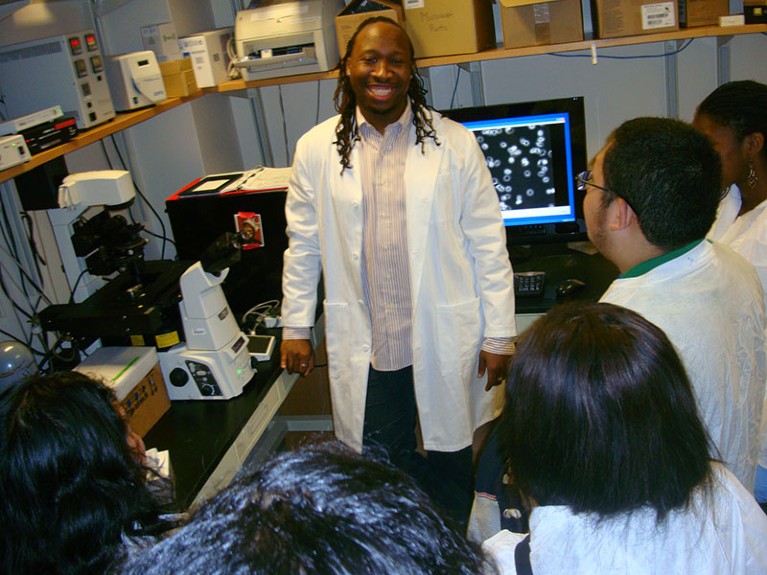
Manu Platt urges members of hiring panels to advocate for talented students in their labs. Credit: Courtesy of Manu Platt
I advise members of hiring panels to advocate for talented PhD students and postdocs in their programme and incentivize them to stay. This is especially true for researchers from under-represented communities because universities are now putting more emphasis on recruiting them.
I benefited from this approach in 2006, when I was encouraged to apply for faculty positions in my department after finishing my joint PhD programme at Georgia Institute of Technology and Emory University, both in Atlanta. Robert Nerem, a bioengineeer and my long-time mentor, had advocated for me behind the scenes. It made me feel valued and created a sense of loyalty. This motivated me to return to my old department, which I did after completing a two-year postdoctoral placement at Massachusetts Institute of Technology (MIT) in Cambridge.
I have a diverse lab and am proud of it. I’ve trained 12 PhD students — and among the 10 who have graduated so far, 4 are Black women, one is a Korean woman and one is a Filipino American man. Four women have also obtained tenure-track faculty positions. Of the 60 undergraduate researchers my lab has trained, at least 30 are from under-represented communities in science, technology, engineering and mathematics.

Nature Career Guide: Recruitment
I do not intentionally shape the composition of the lab, but my research focus and personality tend to attract people who care about diversity, equity and inclusion. My lab works on projects that tackle conditions including aggressive breast cancer in young women in Ethiopia and sickle-cell disease, which disproportionately affect resource-poor communities — and, in the latter case, minority ethnic groups. This attracts students who care about global health and equitable health access. I enjoy cultural diversity and organize lab socials for us to learn about one another’s culture.
It is particularly challenging for junior faculty members to recruit when there are ‘superstar PIs’ in the same department. They need to actively promote their research and brand to offer something special. A good lab website lets potential students know who you are and what you do. Our photo page on lab social activities includes our participation in a Sickle Cell Disease Foundation charity race to show the fun side of my group. For the People page, I ask all lab members to pick a theme song to help prospective students learn what our team members are like as people. Mine is Drake’s ‘Nice for What’ because the lyrics celebrate Black women and empowering oneself. It feeds my soul.
Faculty members who are recruiting should try to attend all of their department’s recruiting events, such as socials, poster sessions and campus-orientation sessions. This will get your name out there and give you an opportunity to interact with students and let them know you personally. For example, I met one of my first PhD students when she was doing summer research at MIT, and I became her postdoc mentor. The ability to build rapport and trust is key to recruiting talented people.
It can be hard to shortlist a handful of candidates from hundreds of applications. I find it helpful to attend ‘Meet the Faculty Candidate’ events, at which candidates present their research visions in posters and circulate one-page research statements and CVs. Members of recruitment committees can either do a targeted search for individuals in a particular field or ‘shop’ around the poster hall looking for people doing interesting research.
The pandemic might mean that such events go hybrid, with much-reduced in-person interaction. Candidates can still shine by producing short videos to introduce themselves and their research virtually, which can be helpful when it is time to shortlist applicants for interviews.

LARA URBAN: Be fair and consider using social media
Conservation genomics researcher and principal investigator at the Helmholtz Pioneer Campus and Helmholtz AI in Munich, Germany, and at the Technical University of Munich School of Life Sciences in Freising, Germany.
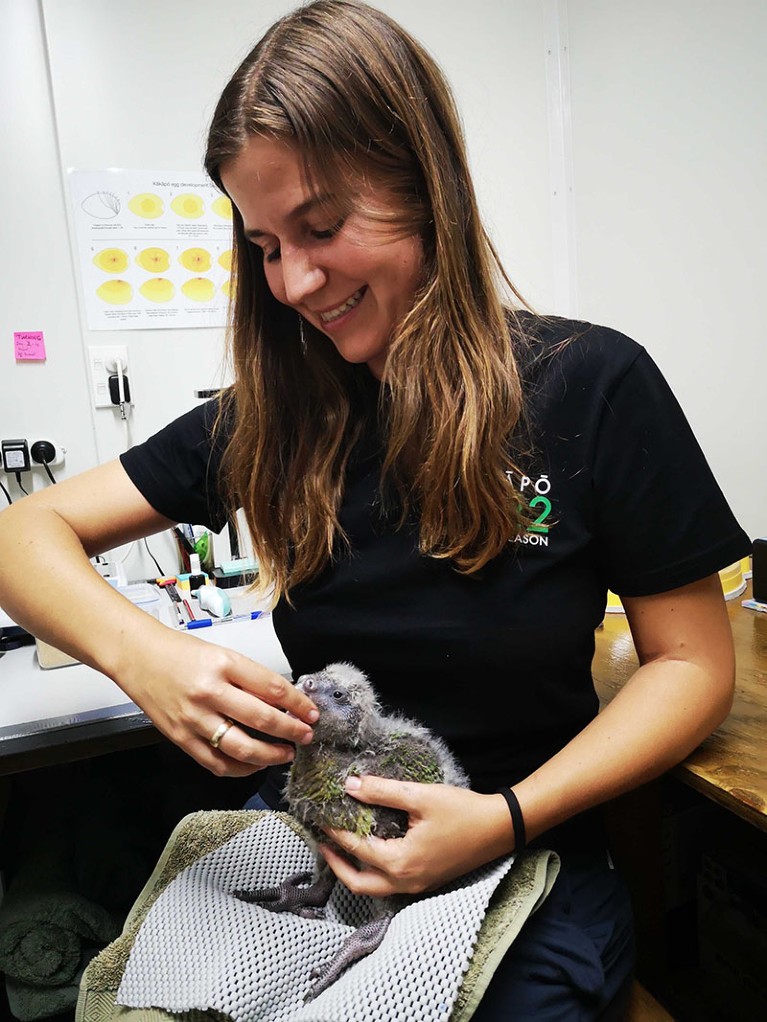
Lara Urban uses social media to share research openings, and avoids making job descriptions too specific. Credit: Lydia Uddstrom
I began my own research group at Helmholtz Munich, the German Research Center for Environmental Health, in June 2022. I’d been interviewed remotely from New Zealand, seven months earlier. The hiring process consisted of a presentation and interviews over the course a week.
Internal candidates also presented virtually, so the recruitment process felt fair to people like me who couldn’t travel. The 12 interviewers included a director of diversity, equity and inclusion to make sure that the process was fair to under-represented researchers. Three of the four candidates given offers were women.
The presentations were organized in the style of open seminars, and everyone was invited to attend. This allowed me to understand the future direction of the institute by seeing the research interests of the 11 shortlisted candidates, and to evaluate if I was a good fit for the institute, and whether I would be surrounded by colleagues with whom I could collaborate.

How we boosted the number of female faculty members at our institution
It is challenging for me to hire as a junior faculty member because I am not yet established. I understand why people prefer having a senior professor as their supervisor, because experienced supervisors have a stronger track record and a more extensive professional network than I do. But joining a young lab means that students and postdocs get to learn how to set up a lab from scratch.
I plan to involve my lab members in this process, and I feel that the experience will prove extremely valuable to them — even if they move to industry to lead a team. They also get to play a central part in creating the work culture they want in a young lab.
I have two strategies to ensure that I reach out to as many candidates as possible. First, keeping the job description broad, by listing a range of desirable rather than specific skills, allows me to shortlist and interview candidates who have the right motivation. Even if their interests do not exactly match mine, we can find overlaps and think of a project that both of us are excited about. So far, I have interviewed promising candidates and have accepted my first PhD student.
Second, I make use of social media, especially Twitter, to share research openings. Junior faculty members such as me are under pressure to publish. This can create perverse incentives for us to hire candidates from ‘advantageous nations’ (by this, I mean countries from which it’s easier to recruit; so, here in Germany, that means other European Union countries). Such candidates can get on board earlier because of their visa status and because their previous degrees are more likely to be recognized. It is important to give under-represented researchers the same chance. I find that advertising jobs using social media can help to address this issue a little. Twitter gets the message out instantly — and by reaching as many potential candidates as possible, and enabling information to flow faster, it can make up for time needed for procedures such as visa applications.
MENG HOW TAN: Embrace your situation and be quick to act
Associate professor of chemical and biomedical engineering at Nanyang Technological University, Singapore.

Meng How Tan keeps alumni updated on the progress of his department and encourages them to share their experiences. Credit: Nanyang Technological University, School of Chemistry, Chemical Engineering and Biotechnology
I advise hiring managers to act fast once they find a good candidate. After Singapore closed its border in 2020 because of the COVID-19 pandemic, professors here had to compete with one another for local candidates because foreign postdocs could not enter the country. I was too slow to act when a promising candidate emerged, and the person quickly found an alternative lab. I learnt my lesson and next time acted faster. When hiring, it is also crucial to work closely with colleagues in the human-resource team so that you know the legal requirements and what documents are needed to smooth the recruitment process.
As well as recruiting academic staff, I take care of non-academic affairs for undergraduate and graduate students in my department. This requires me to think of ways to attract the best students to our programmes and to engage students and alumni. I do this by organizing orientation and career talks involving alumni. I believe in keeping alumni updated on the progress of our department.
Competition to attract the best undergraduates is stiff in Singapore, where only the top 30% of the population, in academic terms, get to study at the island’s public universities. Before the pandemic, my department organized tea sessions with outstanding secondary-school students, their teachers and parents, to talk about our programmes and what undergraduates can expect to gain. We gave school talks and exhibited some of our research prototypes. In Asia, parents strongly influence what their children study. From my experience, parents are most concerned about career prospects, so we encourage alumni to share their experiences and to convince prospective students and their parents of the value of our degree programmes.
At the peak of the pandemic, my colleagues organized virtual lab tours on YouTube and reinvented our recruitment strategies. For instance, my university started featuring research related to the pandemic, including a project from my lab on COVID diagnosis. Over the past two years, we’ve seen an increase in the number of strong applicants wanting to read bioengineering.
STEPHANIE SEIDLITS: Think out of the box and provide regular updates
Associate professor of biomedical engineering at the University of Texas at Austin.
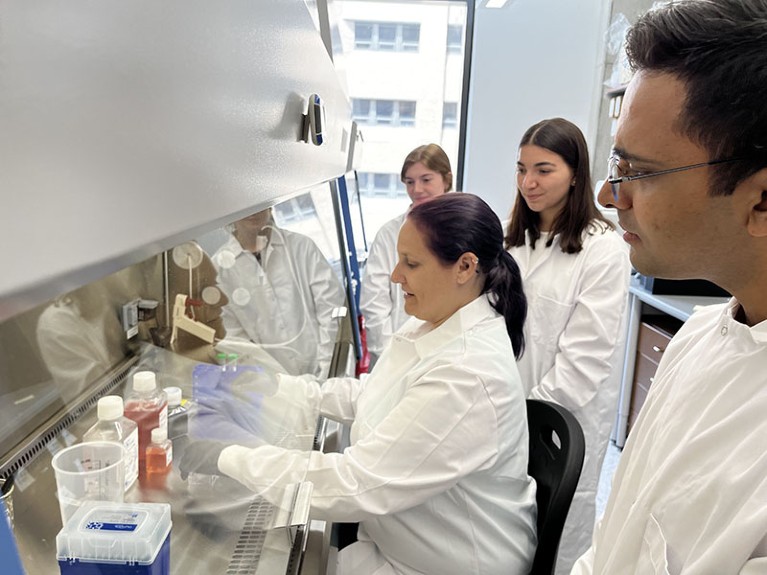
Stephanie Seidlitis motivates new lab members by giving them the chance to start their own projects and take on leadership roles. Credit: Alireza Sohrabi
When I moved to the University of Texas at Austin in January 2022, I faced the possibility of delays in getting new lab supplies because of the pandemic. Thankfully, the university had hired me in 2021 through an adjunct appointment so that I could activate my start-up funds and begin making purchases. I felt that this was a sincere gesture, which affirmed the institution’s commitment to my recruitment and was especially important during an uncertain time such as the pandemic.
Two postdocs and one senior graduate student relocated with me from the University of California, Los Angeles. I really appreciate their support. It is incredibly valuable to have their expertise and not have to build the lab all over again by myself. It is important to recruit and retain talented lab members and to nurture them — by showing them that we’ll provide opportunities for success and exploration, for example — so that we can all benefit from working together. When lab members have moved here from another city, I motivate them by giving them the chance to start new projects, expand their professional networks (I connect them with colleagues here and in Los Angeles) and become leaders in my new lab.
It is crucial to be creative to attract talent to your lab. I could have said no to PhD students looking for a lab rotation, because my lab space was not ready when I started here, but instead I initiated a virtual rotation for several first-year PhD students. We’d already had some experience with virtual research from the start of the pandemic, so we had some idea of how to interact effectively. During virtual rotations, students were invited to lab meetings with a more senior lab member as their mentor, who involved them in analysing data for our projects and future publications. I ended up accepting two PhD students on rotation into my lab and I intend to include them as authors in future manuscripts.
XUN-LI WANG: Be focused and encourage team effort in recruiting
Professor of physics at the City University of Hong Kong.

Xun-Li Wang emphasizes the importance of referrals, and encourages colleagues to help with recruitment by using their personal contacts. Credit: City University of Hong Kong
I promote my university and department during conference talks and seminars at universities where I know there might be people interested in joining my team. When doing presentations and poster sessions, I stress to potential faculty candidates the resources that we offer, such as access to cutting-edge equipment, and the leadership opportunities available in our young and dynamic department. Our old department was split in two in 2017, and most of the faculty members went to the newly created Department of Materials Science and Engineering, leaving only 12 of us in the Department of Physics. We focused our recruitment effort on five research themes, including quantum physics and soft matter. We have now grown to 26 faculty members, including 11 who were hired during the COVID-19 pandemic.
I believe in team effort, and encourage my colleagues to help with recruitment through their personal contacts. Six recent faculty appointments came through referrals. I am also seeing more and more of my colleagues’ collaborators applying to our department, which is a good indication that our reputation is becoming stronger.
I suggest making use of both conventional and emerging advertising platforms to maximize the outcome of recruitment efforts. My department advertises faculty openings in the careers sections of Nature and Science, to reach out to a wide audience, as well as in field-specific magazines such as Physics Today and Physics World . We have also recently started using Facebook and Twitter to promote our department’s achievements and job openings on social media.
Nature 609 , S25-S27 (2022)
doi: https://doi.org/10.1038/d41586-022-02828-z
These interviews have been edited for length and clarity.
This article is part of Nature Career Guide: Recruitment , an editorially independent supplement. Advertisers have no influence over the content.
Related Articles

- Institutions

Shrouded in secrecy: how science is harmed by the bullying and harassment rumour mill
Career Feature 16 APR 24

‘Shrugging off failure is hard’: the $400-million grant setback that shaped the Smithsonian lead scientist’s career
Career Column 15 APR 24

Citizenship privilege harms science
Comment 15 APR 24
Female academics need more support — in China as elsewhere
Correspondence 16 APR 24
Brazil’s postgraduate funding model is about rectifying past inequalities
Correspondence 09 APR 24

Exclusive: official investigation reveals how superconductivity physicist faked blockbuster results
News 06 APR 24

Larger or longer grants unlikely to push senior scientists towards high-risk, high-reward work
Nature Index 25 MAR 24

A fresh start for the African Academy of Sciences
Editorial 19 MAR 24
Postdoctoral Research Associate position at University of Oklahoma Health Sciences Center
Postdoctoral Research Associate position at University of Oklahoma Health Sciences Center The Kamiya Mehla lab at the newly established Departmen...
Oklahoma City, Oklahoma
University of Oklahoma Health Sciences Center
Computational Postdoctoral Fellow with a Strong Background in Bioinformatics
Houston, Texas (US)
The University of Texas MD Anderson Cancer Center
Locum Associate or Senior Editor (Immunology), Nature Communications
The Editor in Immunology at Nature Communications will handle original research papers and work on all aspects of the editorial process.
London, Beijing or Shanghai - Hybrid working model
Springer Nature Ltd
Assistant Professor - Cell Physiology & Molecular Biophysics
Opportunity in the Department of Cell Physiology and Molecular Biophysics (CPMB) at Texas Tech University Health Sciences Center (TTUHSC)
Lubbock, Texas
Texas Tech University Health Sciences Center, School of Medicine
Postdoctoral Associate- Curing Brain Tumors
Baylor College of Medicine (BCM)
Sign up for the Nature Briefing newsletter — what matters in science, free to your inbox daily.
Quick links
- Explore articles by subject
- Guide to authors
- Editorial policies

- INTEGRATIONS

Posts containing:
Graduate student recruitment best practices.
Funding, prestige, location, faculty and academics all play into how prosperous an institution of higher learning is. More than anything else, however, a college or university’s success depends on the students who attend it and take their knowledge and competence out into the world.

Luckily, the application of several best practices can offer substantial rewards in the form of more student applications, greater engagement at events and online, and more impressive candidates to shine a light on your school long after they’re gone.
Want to know how it’s done? Let’s look at current trends and challenges, as well as which measures the smartest schools take to overcome them.
Current Trends In Graduate School Enrollment
Graduate school enrollment trends are a mixed bag. On the one hand, fewer students are applying to graduate school, but that doesn’t mean fewer universities are competing for their attendance. Recruitment professionals face a lot of jostling and elbow-throwing to compete for the best and brightest, and that won’t go anywhere anytime soon.
On the other hand, we’re seeing some changes for the better as well. For instance, we will see a greater number of minority students, such as those from Hispanic backgrounds, wh ose graduate school enrollment increases steadily every year .
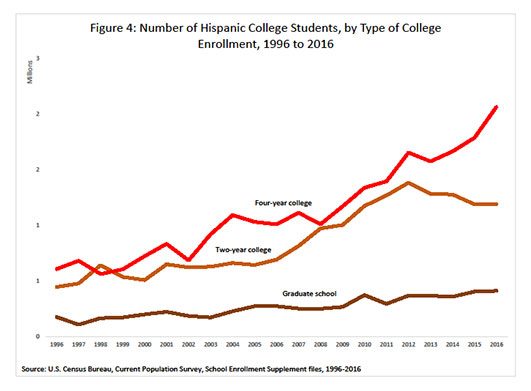
We will also see more students from traditionally less-educated southern states.
Other changes include fewer graduates from religious and other private schools, which depending on your university, may prove a benefit or a concern. Either way, it’s good to note.
“Findings from studies across the last decade indicate that the majority of institutions regard recruitment, admissions and enrollment management as a pressing issue and technology is a frequently acknowledged solution,” says Hanover Research . “A 2012 survey revealed that assistant-ships, phone contacts, and search engine optimization are thought to be highly effective strategies among graduate student recruiters at public institutions.”
This is good news, in the sense that at least universities have a starting place. However, technologies such as phone, text and SEO are so broad as to offer almost no actionable advice in and of themselves.
Challenges In Recruiting Graduate Students
The main reason recruitment and admissions offices are seeing fewer results from their efforts is because of the rapid decline of students applying to graduate programs. When fewer students apply, you have to work harder to attract the same number.

The reasons for this vary, but include a stagnation in the number of high school graduates , an economy in which undergrad degree-holders can make significant five-figure incomes at entry-level jobs, and reports of stagnation and low pay in some fields, even with a graduate degree (especially humanities).
Other strikes against a graduate education include increases in tuition to make up for decreases in public funding , diminished academic opportunity and fewer student services.
Are these challenges insurmountable? No.
In fact, another of the main problems recruitment offices currently face is the belief that they must work harder rather than smarter . The truth is, more hustle won’t necessarily get you the results you’re looking for. Instead, you need to recreate your recruitment system so that it:
- Offers students timely information about your school and programs the moment they request it
- Encourages face-to-face contact with prospects without deprioritizing effective technological tactics
- Helps you stay in touch with prospects effortlessly throughout the research, application and enrollment process
- Presents your school in the most organized and appealing light, from the first point of contact to commencement
Luckily, by putting the right practices into place, you can do just that.
While not every college or university has cracked the recruitment code, there at least exist today some widely acknowledged beliefs on where to begin. These include:
1. Implement a Graduate Enrollment Management Plan
A graduate enrollment management plan should include your mission, goals, and target student profiles. Once you have determined what these are, you need to build those considerations into the enrollment process, coordinating student recruitment, marketing, tuition and financial aid, academic portfolio offerings, and student support services.
The plan should be broken up into three processes:
- Translate your university’s mission into a strategic plan
- Establish clear enrollment goals
- Identify optimal academic offerings
- Set up a framework for student support services
- Target key student success objectives

- Achieve and maintain optimum enrollment
- Promote student success
- Create and deliver in-demand academic programs
- Provide top quality student services
- Generate tuition revenue
- Create marketing messaging
- Collect key data to track activity and progress
- Review and continually improve cross-departmental communications and collaboration
- Look for opportunities to improve organizational efficiency
- Assess student and department satisfaction to develop improved services
2. Start Recruitment When Students Begin the Application Preparation
According to Ruffalo Noel Levitz , one of the biggest mistakes recruiters make is to wait until application time to start marketing. Prospective applicants, however, start thinking about their choices long before this.
Your best bet is to develop a marketing strategy that begins when they do. Buy GMAT and GRE test names and reach out; travel to feeder schools at all times of year; and make sure your website never has extended downtime during perceived “low” times of year (summer and winter break, for instance).
3. Respond to Inquiries Immediately
Whether it’s by phone, email, text or automatic download, it’s critical you respond to inquiries as fast as humanly (or robotically) possible.
Having a system that helps you manage all of your communications so nothing falls through the cracks and ensures that you respond to student requests right away is an absolute must.
4. Make In-Person Events Part of Your Strategy
It’s tempting to refer your recruitment efforts to online technologies that have proven effective, such as social media and SEO. However, while these are powerful tools, they are poor substitutes for the buy-in created by face-to-face tactics such as fairs, brunches, alumni events and more.
Students today are looking for personal connection as we discussed in our article, How Student CRM Recruitment Software Helps Increase College Enrollment Numbers .
5. Analyze Your Results
No matter how tried-and-true a strategy, or how exciting a novel approach, they’re not worthy anything if they don’t work for your school.
No matter what you implement, you must track the effectiveness of each method. That means using software that tracks and monitors student outreach, engagement, applications, admissions, enrollment and every other step in the graduate life cycle.
6. Use Recruiting Software That Facilitates Endless Customization
Without the capacity to customize, you lose the ability to hold onto systems that are working while implementing new systems to increase results.
Instead of switching to limited new software – especially an expensive, inefficient out of the box option – you need solutions that can integrate with systems you’re already using .
Not only that, you need modules that play nice with one another and help you create touch points for every stage of the graduate recruitment process .
Graduate student enrollment is getting more complicated and competitive every day. The old way of doing things doesn’t work when your competitors are incorporating new and more technological ways to ensure they meet their enrollment numbers.
Universities that implement a plan, use the five best practices we outlined, and incorporate the best student recruitment software tools to get the job done stand a better chance of reaching the enrollment goals now and in the years to come.

Jeff is the founder, CEO, and Chief Software Architect of AdmissionPros. Jeff graduated with honors from Western Carolina University with a degree in Computer Science. AdmissionPros believes our success depends on building productive and successful relationships with our clients.
Ready to see how our custom software solutions can grow your numbers? Request a personliazed demonstration today!
Connect with us, admissionpros.
Cary, NC Tel: 919-256-3889

UC Davis Graduate Studies

Outreach and Recruitment
First impressions matter.
The quality of a graduate program depends, in part, on having a group of intellectually talented, highly motivated, and well-prepared students from diverse backgrounds. The purpose of outreach and recruitment is to make the quality of UC Davis’ programs and faculty known to a greater and more diverse number of qualified potential graduate students — to increase the number and diversity of applications in order to ensure that top ranked applicants select UC Davis for their graduate studies.
Best Practices in Graduate Student Recruitment
Research and benchmarking.
Graduate Studies encourages graduate program faculty and staff to become familiar with documented best practices in graduate student recruitment. The following research reports address recruitment best practices, both broadly and specifically to prospective graduate student audiences.
- Noel-Levitz and NAGAP - Marketing and Student Recruitment Practices for Master's-Level Graduate Programs The National Association of Graduate Admissions Professionals (NAGAP) and Noel-Levitz conducted a national, Web-based poll to determine and report the most effective practices. Included in the findings are some benchmark admissions data from a limited number of respondents.
- Hanover Research - Best Practices in Graduate Student Recruitment In this report, Hanover Research examines best practices in graduate student recruitment. In addition, this report profiles marketing and recruiting practices at a number of large public universities.
- Ruffalo Noel Levitz - 2017 Marketing and Student Recruitment Report of Effective Practices
- Ruffalo Noel Levitz - 2018 Marketing and Student Recruitment Report of Effective Practices
- Though this new report is focused on undergraduate recruitment, it can help program faculty and staff identify the up-and-coming trends in higher education recruitment and admissions.
Tips from Graduate Studies
- Develop strategies for the full admissions funnel.
- Don't wait until prospective students apply to begin recruiting! Invest in efforts to attract inquiries and grow and shape the applicant pool. Consider traditional strategies such as tabling at grad school fairs, feeder institution visits, and GRE/GMAT name buys. Most importantly, pay special attention to your website and it's content. Focus your efforts on strategies that will help move prospective students through the admission funnel - from inquiry to applicant, applicant to admit, admit to SIR and so on. Use the graduate program data reports developed by Graduate Studies to gain a firm understanding of your program's unique recruitment strengths and opportunities for improvement.
- Address graduate students’ priorities on your website and in print materials.
- Prospective graduate students consistently indicate three key priorities—the quality of the program, the cost/affordability, and the pathway or career available. Be sure to highlight your faculty's research expertise as well as student career successes on your website. Don't just list it out - update your website consistently with stories and profiles of your faculty, students, postdoctoral scholars, and alumni and contact the Graduate Studies Marketing and Communications team to promote it broadly.
- Invest time and effort in strategies that work.
- While it's tempting to invest your limited recruitment funds in glossy print publications, social media advertising, or conference travel, pay close attention to the practices that work. There are clear “best practices”—from campus visits for prospective students to web pages for international candidates to phone calls placed to admitted students—that contribute to enrollment success. Carefully track the source of your applicants and invest in the strategies that enable you to reach and recruit students that enroll.
- Be up front with information about funding and financial support.
- These days, prospective graduate students are often wary about making an investment in their graduate education. Be clear about the costs and funding opportunities associated with your program, and connect them to financial support information early and often.
- Use technology to build relationships and improve the prospective student experience.
- Digital communication platforms (such as the website, social media channels, and email systems) should be used to start a conversation rather than broadcast one-way messaging. Make sure that your website makes it easy for prospective students to find information, contact graduate program coordinators, and apply on the Graduate Studies website. Graduate program staff are encouraged to monitor the status of applications using Slate.
Partner with Graduate Studies
Brochures and print publications.
Graduate Studies is reducing its investment in print publications. However, we contribute to and host a number of publications in digital formats. We recommend pointing prospective students toward the UC What's Next? brochure , a UC-wide graduate studies publication that includes information on the different campuses, graduate programs, application processes, and funding opportunities. A select number of printed What's Next? brochures are also available through Graduate Studies.
Graduate School Fairs, Conferences and Consortia
As part of a centralized outreach and recruiting effort, Graduate Studies sends representatives to numerous information fairs at California State University campuses, as well as sister UC campuses. Additionally, Graduate Studies frequently participates in a number of consortia and attends conferences that permit identification and recruitment of a diverse pool of students. Faculty members are welcome to accompany Graduate Studies staff to these events. For information about Graduate Studies' recruitment travel schedule, contact the Admissions and Outreach team .
Please enable JavaScript in your web browser to get the best experience.
We use cookies to track usage and preferences.
Primary navigation
Phd students.
- Exhibitions
- Translation
- Work experience
PhD student recruitment
Applications for the 2024 spring round are now closed.

Introduction
What we offer .
We offer successful applicants a place on the Crick PhD programme , and a PhD studentship that covers:
- £26,125 tax-free student stipend (living allowance) per year for four years
- Tuition fees
- If applicable, reimbursement of the student visa application fee and immigration health surcharge
Any questions?
Get in touch with us by sending a message to [email protected] .
Eligibility & academic entry criteria
Candidates of all nationalities can apply for the Crick PhD programme and studentship.
The standard Crick PhD programme and studentship academic eligibility criteria are:
- A first/upper second-class honours degree (or equivalent from a non-UK university) in a relevant subject.
- Appropriate research experience as part of, or outside of, a university degree course, or a master's degree in a relevant subject.
Please note that a small number of positions have additional eligibility criteria due to the funding that is supporting that position. If this is the case, details about the additional criteria are provided at the top of individual position page.
English skills
Applicants do not need to submit information relating to English language skills during the application process. If you are offered a Crick PhD studentship we will provide you with information on our English language requirements.
Applications
Application timeline, tuesday 19 march 2024.
Application deadline (12 noon GMT)
Tuesday 26 March 2024
Reference deadline (12 noon GMT)
By (end of the day) Thurs 25 April 2024
Applicants informed of application outcome, either invited to interview or unsuccessful
Thursday 09 May 2024
Panel interview, by Zoom
Monday 13 May 2024
Open Morning & Lab visits, in person at the Crick
By (end of the day) Mon 03 June 2024
Final outcome communicated
Key information
- Your application must be submitted by the deadline: 12 noon (GMT), Tuesday 19 March 2024.
- We will not accept late applications.
- We should receive your references by 12:00 noon (GMT), Tuesday 26 March 2024.
After the reference deadline:
- Your application will be reviewed first by members of the Crick’s Academic Training team (junior researchers), who will check that you meet the minimum eligibility criteria.
- After this eligibility check, your application will be made available to all the recruiting Group Leaders (up to 3) that you selected on your application form.
- In order to reduce the potential impact of unconscious bias, recruiting Group Leaders will not see your name when they first review your application.
- Group Leaders will review and shortlist applications. Some Group Leaders may invite other members of their group to participate in this initial shortlisting.
- Group Leaders will see the names of any candidates (as many as they wish) that they add to their shortlist.
- Some Group Leaders may choose to contact some applicants for an informal discussion during this shortlisting period, and so please continue to monitor your email.
- If you do not hear from a Group Leader that you selected on your application form this does not mean that you are not in active consideration; you may still be shortlisted for invitation to interview.
- The Crick receives around 1500 applications for its PhD programme. Given the high volume of applications, it take us some time to review all applications thoroughly. We will notify you of the outcome of your application by the end of the day on Thursday 25 April 2024.
After the interview
The interviews will take place over two days in May 2024 and involve a panel interview, followed by an open morning and lab visits. Dates are given in the timeline above.
If you are invited for interview, we will ask you to share any access or reasonable adjustment needs that we will need to support during the recruitment process.
Stage one involves a panel interview (by Zoom) with three or four recruiting Group Leaders.
The interview process will also include an open morning and lab visits, which will take place in person at the Crick and will involve:
- The opportunity to find out more about the Crick and the PhD programme.
- Lab visits with the Group Leaders that candidates were shortlisted by. Lab visits involve a 1-1 interview with the Group Leader and an opportunity to meet members of the research group.
Full details will be provided to candidates that are invited to interview.
Travel expenses will be covered in accordance with the guidelines provided, and accommodation will be provided if required for the open morning and lab visits aspects of the interviews.
The Crick will cover the cost of a visitor visa for candidates that require a visa to travel to the UK.
If you are successful in your interview and are offered a position on the Crick PhD programme, you and your supervisor will decide on the most appropriate partner university for you to register at (Imperial College London, King's College London, or University College London).
The decision will be based on 'scientific fit' as you and your supervisor will also have to nominate a member of staff from that university to act as a secondary supervisor on your thesis committee.
Once this decision has been made you will be provided with information and guidance on how to apply for admission as a PhD student on the Crick Programme to the relevant university. The Crick PhD Programme will begin in late September 2024.
How to apply: 2024 PhD programme
Guidance for applicants to the 2024 PhD programme.
Positions: 2024 PhD student programme
PhD projects for the 2024 Crick PhD programme.
Our PhD programme attracts the brightest scientific minds and is an opportunity for talented people to embark on their career in biomedical research.
Share the page
- Share on Twitter
- Share on Facebook
- Share on LinkedIn
- Share on Email
Sign up for our newsletters
Join our mailing lists to receive updates about our latest research and to hear about our free public events and exhibitions. If you would like to find out more about how we manage your personal information please see our privacy policy .
The Francis Crick Institute is a unique partnership between

Future Students
Faculty & research scientist phd student recruitment.
The following HCDE faculty advise graduate students, and some have provided statements about whether they plan to work with new students in the upcoming year.
Even though faculty capacity and match can change, we particularly encourage you to look into faculty who plan to work with new students, as difficult admission decisions often come down to advising capacity.
Because plans change based on how research progresses, which grants are awarded, and changing commitments for faculty and current students, consider identifying faculty in your application who describe appealing openings and faculty who most strongly match your research interests, even if they are not currently planning to work with new students in the coming year.
HCDE Faculty
Hcde research scientists, adjunct faculty.
The following adjunct faculty (faculty with primary appointments in other departments but who also hold appointments in HCDE) have expressed interest in recruiting and working with HCDE PhD students. You might also identify them in your application, but we discourage you from listing only adjunct faculty: we require doctoral students to have a co-adviser in HCDE as well, since it helps to have a mentor and advocate who is in the same department as you.
Many HCDE PhD students are also co-advised by and work with UW faculty in HCDE or other units, through collaborations that emerge during their time in the program.
Browser does not support script.
- Undergraduate
- Executive education
- Study Abroad
- Summer schools
- Online certificate courses
- International students
- Meet, visit and discover LSE

Virtual information session for graduate offer holders
Online information session, United Kingdom

Nathan Brennan
Student recruitment officer (international).

Graduate Admissions Office
Join our webinar for graduate offer holders to get information about what to expect when you arrive at LSE.
Get updates from Graduate Admissions, and an overview of the next steps you need to take in order to confirm your place at the School. The webinar will consist of a brief presentation followed by a live Q&A, where you will have the opportunity to ask us any questions you may have regarding your next steps.
The event will take place online via Zoom . To attend the session, you will need to register in advance by clicking on ‘How can I attend?’. After registering you will receive a confirmation email which will include a Zoom webinar link. You will be able to access the event on the day via this link.
The session is relevant for applicants who have received offers to study at LSE for Master’s and PhD programmes only. Please note that it will not be possible to comment on individual applications during this event. In order to discuss your offer, you should contact Graduate Admissions through the options listed here .
The event will be recorded and made available to all graduate offer holders in the days following. If you cannot attend the webinar on this date, we will be scheduling additional dates later in the year.
Please note that all event times are in UK local time.
Read our Code of Behaviour before attending our events.

Events for Offer Holders Destination LSE
Academic Student Employee Open Recruitment
- Graduate Assistant, Fitness Instruction Primarily responsible for the coordination of the UREC non-credit group fitness and instruction programs. Graduate Assistant will supervise, train and evaluate temporary employees to deliver classes in a variety of disciplines including group fitness, dance, and martial arts. Will also assist with UREC weight room attendants and personal trainers. Qualifications: please visit the University Recreation Employment […] April 12, 2024
- Graduate Assistant, Facilities & Membership This position is primarily responsible for the day-to-day operation and administration of facility operation and membership services for the Chinook Student Center. This position will share responsibility for the primary management, supervision, scheduling of membership, office, and facility manager staff for University Recreation. The Facilities & Membership Graduate Assistant will be responsible for training, evaluation, […] April 12, 2024
- Graduate Assistant, Cougar Crew Responsible for the development of technically, mentally, and physically competitive student-athletes to represent Washington State University Cougar Crew, a varsity-club sport within University Recreation. Duties include active and ongoing recruitment, implementation of an effective training program under the direction of the Head Coach for Cougar Crew, as well as ensuring team compliance with University Recreation […] April 12, 2024
- Graduate Assistantship–System Strategy and Insight/Institutional Research and the Office of the Provost Institutional Research and the Office of the Provost are seeking a graduate assistant for the 2024-2025 academic year, with funding beginning in the upcoming fall term. This is a training position to support activities related to the support of Activity Insight, the reporting tool for faculty annual reviews. Excellent written and oral communication skills are essential. […] April 12, 2024

Graduate Program Manager
- Madison, Wisconsin
- SCHOOL OF MEDICINE AND PUBLIC HEALTH/ANATOMIC PATHOLOGY
- Academic Services and Student Experience
- Partially Remote
- Staff-Full Time
- Opening at: Apr 11 2024 at 16:35 CDT
- Closing at: May 3 2024 at 23:55 CDT
Job Summary:
The Graduate Program Manager will serve as the main department contact for all graduate and undergraduate educational endeavors. The successful candidate will report to the Chief Administrative Officer. The primary responsibilities for this position are developing, implementing and managing student and academic services for the Department of Pathology and Laboratory Medicine including the Cellular and Molecular Pathology (CMP) Graduate Program (on average enrolls 8-12 new graduate students per year) with overall enrollment of approximately 55 students. This position is responsible for the day-to-day operations of the graduate program including recruitment, training and matriculation of students and course support. Other responsibilities include academic oversight and coordination of graduate and undergraduate courses, program related grant renewals (ie T32), assistance with medical student clerkships and other rotators, as needed, and participation on educational committees.
Responsibilities:
- 20% Serves as the expert resource for applicants, current students, faculty, staff, and other stakeholders of an academic program
- 15% Manages the response, support, and advocacy for graduate students while continuously improving the student experience and overall graduate program
- 20% Oversees programming, services, and events to promote professional development and academic success
- 20% Provides comprehensive advising services promoting graduate student success, retention, and degree completion. Advises on programs, graduate education, and university policies, processes, and procedures. Monitors degree progress and assists students in navigating resources and systems throughout the student lifecycle from matriculation to degree completion
- 5% Manages graduate student funding including, but not limited to, fellowships, scholarships, training grants, or assistantships from department, university, and/or outside sponsors. May prepare and/or submit funding proposals
- 10% Maintains compliance with graduate program(s), school/college, and university requirements and technology systems related to admissions, assessment, academic degree progress/requirements, and program review. Makes policy and procedure recommendations and/or changes
- 5% Oversees staff and/or graduate program functions
- 5% Manages the program T32 participating in the annual progress report process as well as grant renewal submissions
Institutional Statement on Diversity:
Diversity is a source of strength, creativity, and innovation for UW-Madison. We value the contributions of each person and respect the profound ways their identity, culture, background, experience, status, abilities, and opinion enrich the university community. We commit ourselves to the pursuit of excellence in teaching, research, outreach, and diversity as inextricably linked goals. The University of Wisconsin-Madison fulfills its public mission by creating a welcoming and inclusive community for people from every background - people who as students, faculty, and staff serve Wisconsin and the world. For more information on diversity and inclusion on campus, please visit: Diversity and Inclusion
Preferred Master's Degree
Qualifications:
Knowledge/Skills Required: -Excellent organizational skills and ability to exercise initiative when necessary -Strong computer skills particularly with databases, e-learning, word-processing, PowerPoint and computerized student records -Personal or professional experiences relevant to effectively and inclusively engaging and building relationships with learners, faculty, and staff -Maintains confidentiality -Ability to take initiative, coordinate with others, and seek solutions to problems Knowledge/Skills Preferred: -At least one year of experience working with college and/or graduate students providing academic advising, academic support and timetable services -Experience with the Graduate School and other sources of campus support -Knowledge of University policies and procedures desirable
Full Time: 100% This position may require some work to be performed in-person, onsite, at a designated campus work location. Some work may be performed remotely, at an offsite, non-campus work location.
Appointment Type, Duration:
Ongoing/Renewable
Minimum $53,700 ANNUAL (12 months) Depending on Qualifications Employees in this position can expect to receive benefits such as generous vacation, holidays, and sick leave; competitive insurances and savings accounts; retirement benefits. Benefits information can be found at ( https://hr.wisc.edu/benefits/ ). SMPH Academic Staff Benefits flyer: ( https://uwmadison.box.com/s/r50myohfvfd15bqltljn0g4laubuz7t0 ).
Additional Information:
The selected applicant will be responsible for ensuring their continuous eligibility for employment in the United States on or before the effective date of the appointment. University sponsorship is not available for this position. UW-Madison is not an E-Verify employer, and therefore, is not eligible to employ F1-OPT STEM Extension participants.
How to Apply:
To apply for this position, please click on the "Apply Now" button. You will be asked to upload a current resume/CV and a cover letter briefly describing your qualifications and experience, and a document listing contact information for three (3) references, including your current/most recent supervisor. References will not be contacted without prior notice.
Tia Seguin [email protected] 608-263-3731 Relay Access (WTRS): 7-1-1. See RELAY_SERVICE for further information.
Official Title:
Graduate Program Manager(AE093)
Department(s):
A53-MEDICAL SCHOOL/PATHOL-LAB MED/ANAT PATH
Employment Class:
Academic Staff-Renewable
Job Number:
The university of wisconsin-madison is an equal opportunity and affirmative action employer..
You will be redirected to the application to launch your career momentarily. Thank you!
Frequently Asked Questions
Applicant Tutorial
Disability Accommodations
Pay Transparency Policy Statement
Refer a Friend
You've sent this job to a friend!
Website feedback, questions or accessibility issues: [email protected] .
Learn more about accessibility at UW–Madison .
© 2016–2024 Board of Regents of the University of Wisconsin System • Privacy Statement

IMAGES
VIDEO
COMMENTS
Discover the best graduate school recruitment strategies in 2024 and how you can implement them at your institution! Whether you are a school known for your graduate programs, or trying to attract students to innovative, new graduate programs, read on to learn how you can assess and audit your current recruitment efforts, and what you could be doing even better.
Successful recruitment moves masters and doctoral students through several stages of the recruitment process but for the purposes of advancing and strengthening recruitment efforts, these best practices focus on three broad stages: Program visibility and student identification stages. Prospective and application stages.
Continue recruitment post-admission. Getting a student to apply and be admitted is just the first step. The next task is having the student commit and enroll. Continue communication with admitted/committed students. Have faculty or program directors call admitted students to congratulate them and answer any questions.
Successfully Recruiting Research Participants. The semester started off so well. As a newly minted Ph.D candidate, I couldn't wait to start my dissertation research. I enthusiastically wrote an email and survey soliciting study participants, triumphantly clicked send, and sat back and waited for the volunteers to roll in.
A graduate student may manage work assignments and personal obligations, all while completing their thesis. Your university must ensure that faculty feel capable of supporting students' learning, social, and emotional needs as they balance their work, school, and personal lives. Prioritize asynchronous class sessions.
From the perspective someone who recently went through the PhD application process, I'd say that the best way to recruit good PhD students is to recruit good PhD students. While I make no judgment as to whether or not I fall in the "good PhD student" set, I can say that my experience (and from what I've heard--most people's experiences are) was ...
Universities spend significant time and resources in recruiting undergraduate students. Unfortunately, graduate recruiting efforts frequently fall victim to ineffective and inefficient practices. As a faculty member and program director of various higher education graduate programs, I have spent much of my career recruiting masters and doctoral students. I have often been frustrated by the lack
Recruiting for a funded program when the research area of interest has no openings. Failing to recognize that some efforts are part of long term goals, which may not show results for years. STAGE 1: Annual planning STAGE 2: Venue and Engagement STAGE 3: Admits, declines and yield STAGE 4: Analyze and revise. Stages of "the funnel".
Job Search Tips. Identify your skills, interests, and values. PhD candidates have a unique background and blend of skills that may be transferable to a variety of industries. It's helpful to start your career search with a self-assessment to identify what motivates you, what interests you, and what skills (both technical and interpersonal ...
Across the three polls, we surveyed a total of 805 graduate enrollment leaders representing 640 colleges and universities and 50 states. 1. Prioritize personalized, interactive marketing. When we asked graduate enrollment leaders if they were changing their recruitment strategies in light of COVID-19, an unsurprising 98% of participants said yes.
Recruiting talented students and staff can make a difference to laboratories' research outputs, enhance the achievements of principal investigators (PIs) and research groups, and boost the ...
Deans and other institutional leaders can assess their graduate student recruitment efforts using the checklist below. 1. Build an effective outreach and communication pipeline in campaigning students. Yes No Institutions can create visibility by constructing an engaging and easy-to-navigate website.
No matter what you implement, you must track the effectiveness of each method. That means using software that tracks and monitors student outreach, engagement, applications, admissions, enrollment and every other step in the graduate life cycle. 6. Use Recruiting Software That Facilitates Endless Customization.
Discover why most PhD student research recruitment materials fail to engage participants and learn actionable strategies to revamp them. From your posters to your Facebook posts, ensure that your materials meaningfully connect with your participants.
Listservs, or email lists, can work as another great resource for recruiting research participants. This method also reaches a large group of potential research participants. "You can also post recruitment ads to professional listservs for further distribution. Online recruitment allows you to reach a more heterogeneous sample with participants ...
Third-Party Recruiters and Ph.D. Candidates. Natalie Lundsteen offers advice for doctoral students and postdocs looking for nonacademic jobs and considering working with headhunters. Ph.D.s and postdocs who are job seeking outside of academe need all the help they can get, and it is nice to imagine a recruiter (or headhunter) working diligently ...
First Impressions Matter The quality of a graduate program depends, in part, on having a group of intellectually talented, highly motivated, and well-prepared students from diverse backgrounds. The purpose of outreach and recruitment is to make the quality of UC Davis' programs and faculty known to a greater and more diverse number of qualified potential graduate students — to increase the ...
All supervisors know well that recruiting new PhD students is a challenging process. This is because both, the supervisor and the PhD student must commit to the process, that can last at least 4-5 ...
What we offer. We offer successful applicants a place on the Crick PhD programme, and a PhD studentship that covers: £26,125 tax-free student stipend (living allowance) per year for four years. Tuition fees. If applicable, reimbursement of the student visa application fee and immigration health surcharge.
There will be an active recruiting advertisement. Always check his most recent publication year, if it is current or year before then s/he is active in research and recruiting students. Send an email to his/her group members. They will happily respond. Email the graduate coordinator they know who are actively recruiting.
Are you interested in pursuing a PhD in Human Centered Design & Engineering at the University of Washington? Learn more about the faculty members' plans for advising new doctoral students, their research interests, and their current projects. Find out how to connect with potential advisors and prepare a strong application.
Join our webinar for graduate offer holders to get information about what to expect when you arrive at LSE. Get updates from Graduate Admissions, and an overview of the next steps you need to take in order to confirm your place at the School. The webinar will consist of a brief presentation followed by a live Q&A, where you will have the ...
Mount St. Mary's University is a dynamic, Catholic, liberal arts university with over 2,000 undergraduate and graduate students, located in Emmitsburg, Maryland. As a Catholic university, Mount St. Mary's graduates ethical leaders who are inspired by a passion for learning and lead lives of significance in service to God and others.
Graduate Assistant, Cougar Crew Responsible for the development of technically, mentally, and physically competitive student-athletes to represent Washington State University Cougar Crew, a varsity-club sport within University Recreation. Duties include active and ongoing recruitment, implementation of an effective training program under the direction of the Head Coach for Cougar Crew, as well ...
Job Summary: The Graduate Program Manager will serve as the main department contact for all graduate and undergraduate educational endeavors. The successful candidate will report to the Chief Administrative Officer. The primary responsibilities for this position are developing, implementing and managing student and academic services for the Department of Pathology and Laboratory Medicine ...